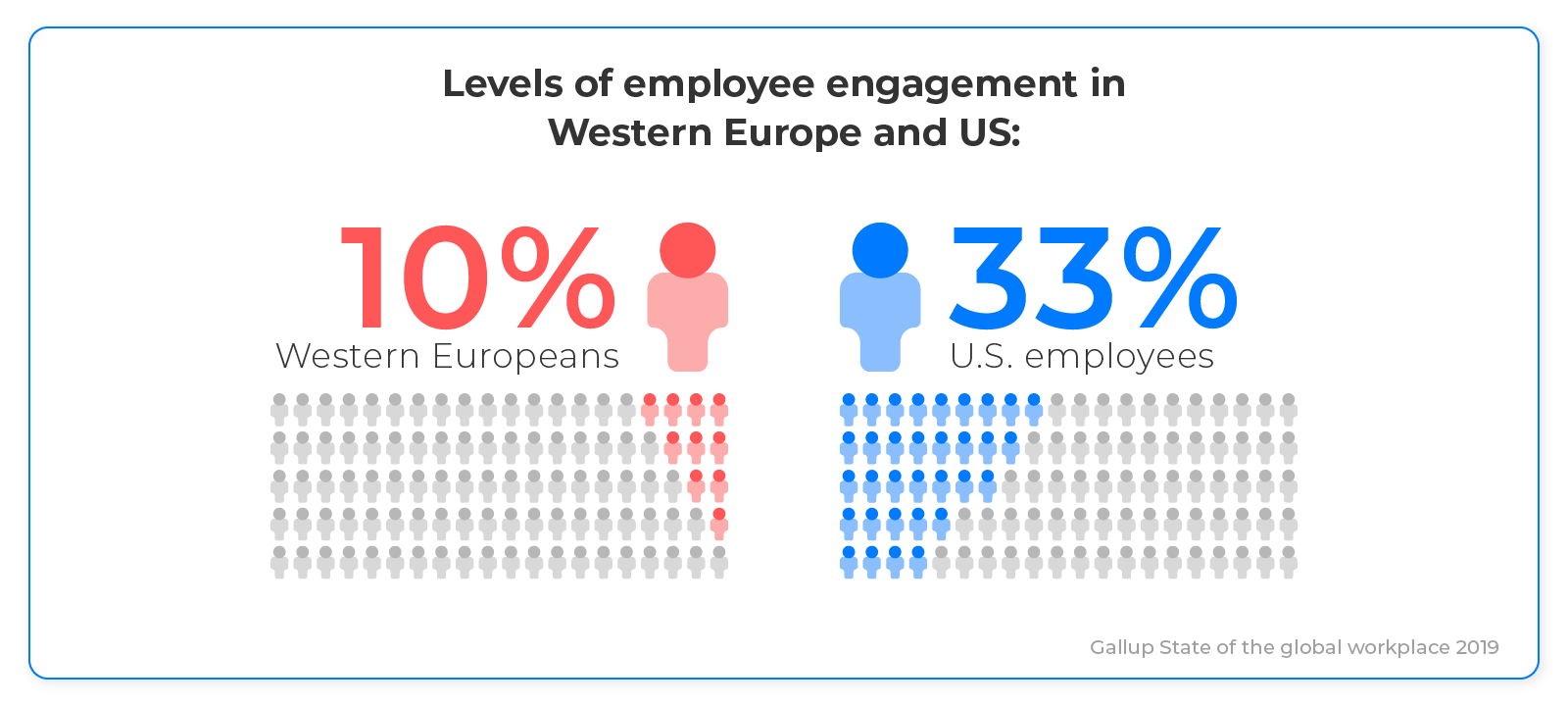It’s worrying when team productivity fizzles or employees become unenthusiastic. There can be countless reasons for this, but one factor that stands out above the rest is employee engagement. Research shows that an alarming 61% of the UK working population admits to feeling disengaged, with minimal motivation to extend efforts beyond their typical job description.
However, identifying the exact source of this can be difficult, especially when you’re looking in all the wrong places. Could you be the cause?
What is employee engagement?
We've explored the definition of employee engagement before. A simplified explanation is that improving employee engagement requires the right conditions for employees to work to the best of their abilities. In turn, this makes it more complex than simply ensuring your workforce is satisfied.
To dive deeper, let's explore the key differences between engaged and unengaged employees.
Unengaged employees
A common assumption about unengaged staff members is that they’re unhappy. In reality, an unengaged employee may or may not be content at work, but are not truly invested in their job role or your company.
They might be seeking distractions, are misaligned from your company’s core values, or aren’t working to the best of their abilities. Unsurprisingly, the list goes on – a whole host of factors contribute to causing lack of engagement amongst employees. It's useful to create your own definition of employee engagement to better understand the causes specific to your organisation.

Engaged employees
Truly engaged team members have a genuine, long-term enthusiasm for your business and a sense of duty towards its success. They have the right conditions to work efficiently, are less likely to seek distractions, and will possess a positive emotional understanding of their role. This means they comfortably go, and want to go, beyond what’s required.
Although a base-line level of commitment is usually expected at work, greater levels of engagement can have notable productivity benefits, with a recent study finding that highly engaged teams provide 21% more profitability to a business.
So, how do businesses improve employee engagement? It can seem logical to reward engagement and discourage the work-shy. Everyone has a responsibility over how they conduct themselves at work and whether they perform their duties.
The reality is that blame doesn’t always rest solely on the employee. It’s vital to consider that leadership, and the methods you choose to direct, influence, motivate, and even reprimand your workforce, will play a crucial role in driving all-important employee engagement.
The impact of leadership on employee engagement
Leadership styles have the ability to positively influence employees, but equally, they can negatively influence behaviour too.
Experts such as The Center for Creative Leadership suggest that people in management roles can your company's greatest assets, but only if they learn how to properly understand and manage employee engagement.
Crucially, while some managers or senior-level staff members possess the qualities of a leader – such as a sense of authority, knowledge, and work ethic – their personal leadership style can stop them being effective. More so, it might be negatively affecting employee morale, motivation, and importantly, engagement.
To identify these behaviours, leadership teams must introspectively assess their management style, soft skills, and the methods they use to connect and communicate with employees.
The 3 most common leadership style mistakes
We've highlighted key behaviours that are telltale signs of an ineffective leadership style, and explore how these methods can influence employee engagement.
1. Overlooking employee listening
Studies show that employees who feel their voice is heard are 4.6 times more likely to feel empowered to do their best work, highlighting an important connection between recognition and employee engagement.
When your staff believe their feedback is listened to, you create a safer environment to share honest opinions. This is more commonly understood as effective two-way communication between leadership and employee, where team members feel comfortable enough to contribute.
However, sending out company feedback surveys alone isn't enough. Too many surveys, with no understanding of what happens next, can cause employees to suffer from survey fatigue. This reduces the quality of feedback, and a loss of interest in leadership team members who never communicate back. Additionally, it can cause staff to seek alternative, and sometimes negative, outlets to voice opinions.
To tackle this, leaders should practice continuous employee listening and use a two-way communication channel to get personal, one-to-one feedback from your teams.
2. Lack of regular communication
A busy calendar and demanding workload is enough to make anyone push their lesser priorities to the wayside. It's easy to overlook minor administration like informing your wider-reaching teams of a routine change to processes, or to share the notes from an important business meeting.
Yet, for your employees, these details can make all the difference. You might be the only source of information they can rely on. They can become jaded by the lack of transparency or the unpredictable nature of their work environment – as changes happen without their knowledge.
Most notably, the benefits of good communication will go beyond this. Simply expressing interest in employees and keeping them informed helps team members stay aligned to your business goals. Teams require clear and consistent communications with the appropriate levels of information to remain engaged. Leadership members can improve this by implementing a company-wide communication channel to make sure important information is available for everyone to see.
3. Reluctance to give recognition
A job well done should be a job well-rewarded (in theory). Although this doesn't apply to every aspect of work culture, a report by Gallup found that even small amounts of recognition by leadership is proven to dramatically improve employee engagement. More surprisingly, the report found that the impact of recognition rises when feedback comes from higher seniority, highlighting that no one – not even your CEO – should be stingy about recognition.
A few encouraging words can engage teams by emphasising appreciation. In turn, this simple act motivates employees and increases the resonance and reach of organisational goals.
Building a better connection with your employees
Great leaders are great communicators. However, it can be difficult to open a dialogue when your workforce aren't all in one office. And, even if they are, conflicting work schedules and the individual needs of your people can become significant barriers to success.
To improve your leadership style, ensure you have an effective method of internal communication that's built to foster all-important, regular touch-points with employees, no matter where they are or who they are. More businesses are now using an employee engagement app to connect and communicate with their employees, leading to greater levels of organic engagement. To learn more, read our handy seven step guide for improving employee engagement.
Topics:
Employee Engagement






.jpg)
.jpg)